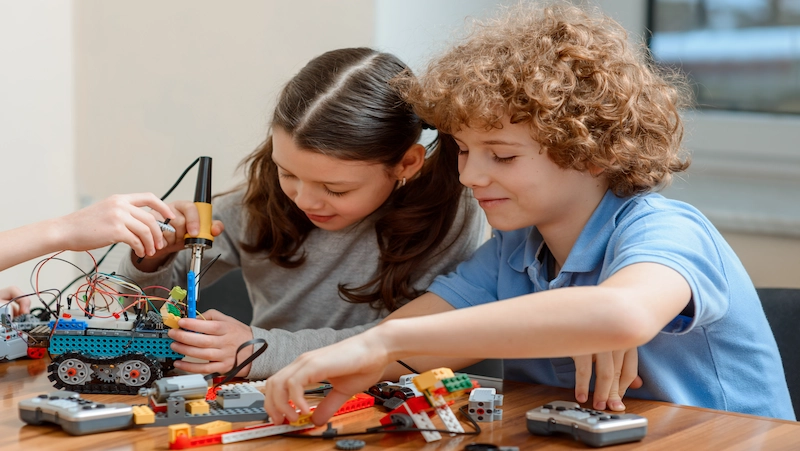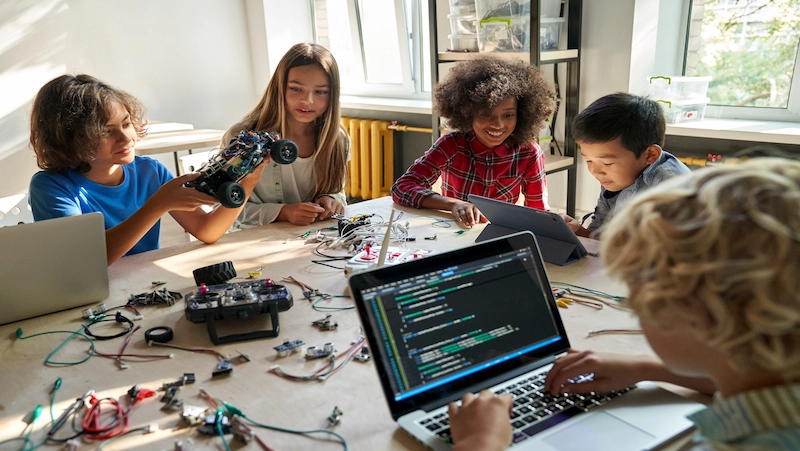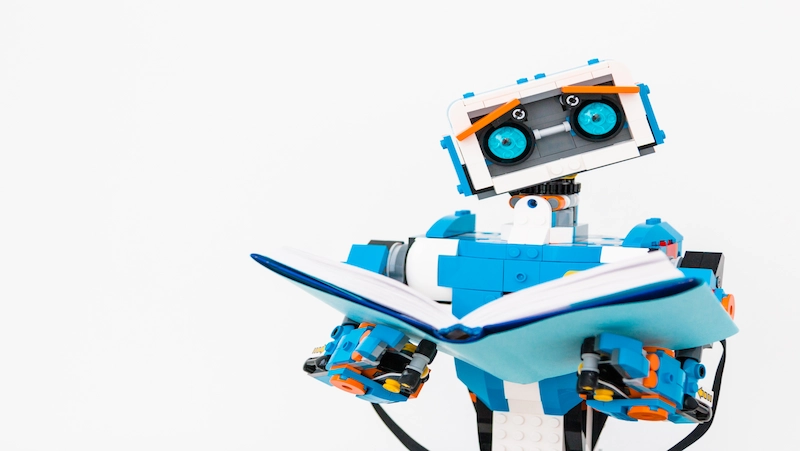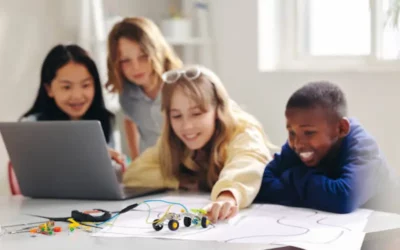In today’s technology-driven world, it’s essential for children to develop skills that will prepare them for the future. Robotics for kids with its captivating blend of science, engineering, and creativity, offers a fantastic opportunity to learn and have fun simultaneously.
Engaging in robotics projects not only sparks their curiosity but also enhances their problem-solving abilities, critical thinking skills, and teamwork.
Table of contents
Introduction
Robotics projects for kids have come a long way from simple mechanical toys. Thanks to advancements in technology and the availability of user-friendly robotics kits, children can now immerse themselves in exciting hands-on experiences that cultivate their interest in STEM (Science, Technology, Engineering, and Mathematics) subjects
These projects encourage children to explore various aspects of robotics, including building and programming robots, designing circuits, understanding sensors, and tackling real-world challenges. They provide a safe and interactive environment for kids to experiment, make mistakes, and learn from them, fostering a growth mindset and nurturing their natural curiosity.
Not only do fun and educational robotics projects help kids develop technical skills, but they also nurture a range of transferable skills. These include problem-solving, logical thinking, creativity, communication, collaboration, and perseverance – all of which are vital for success in the 21st century.
Additionally, engaging in robotics projects can ignite a passion for science and technology at an early age, inspiring kids to consider future careers in STEM fields. By making the learning process enjoyable and hands-on, children are more likely to develop a lasting interest in these subjects, setting the stage for lifelong learning and exploration.
So, let’s embark on an exciting journey into the world of fun and educational robotics projects for kids, where learning is an adventure and innovation knows no bounds!
Benefits of Robotics Projects for Kids

It is critical to provide kids with the skills they need to survive in a world that is becoming more automated in the digital age, where technology plays a big part in our daily lives. While encouraging children’s creativity and problem-solving skills, robotics projects offer an interesting and engaging approach to introducing kids to the concepts of science for kids, technology, engineering, and mathematics (STEM).
In this blog post, we will go through the many benefits of robotics projects for kids, emphasizing how they develop important skills and ignite a passion for knowledge that lasts a lifetime.
Hands-on Learning Experience:
Robotics projects give kids hands-on learning opportunities that go beyond what they would typically study in a classroom. Children actively participate in the learning process by creating robots and programming them to carry out certain tasks.
This improves their comprehension of scientific ideas and logical reasoning, instilling positive thinking for kids. This practical approach promotes a deeper understanding of difficult concepts, making learning enjoyable and memorable.
Encourages Critical Thinking and Problem-Solving:
Robotics projects test kids’ capacity for critical thought and their capacity for problem-solving. They learn to assess the situation, pinpoint the issue, and develop solutions as they face challenges and setbacks during the construction and programming phases.
This repeated process fosters adaptability, resilience, and the capacity for efficient problem-solving—a beneficial mindset applicable to many aspects of life.
Fosters Innovation and Creativity:
Robotics projects give kids a platform on which to express their innovative thinking and creativity. Young brains have the opportunity to experiment, discover, and express their inventive thoughts, from creating distinctive robot constructions to programming them with unique functionalities.
This avenue for creativity fosters uniqueness, unconventional thinking, and a passion for invention and innovation, all of which contribute to the development of critical thinking skills for kids.
Cultivates Collaboration and Teamwork:
Teamwork is frequently required for robotics projects, giving kids the chance to practice crucial collaborative skills. Children get an understanding of the value of effective communication, teamwork, and task delegation while working on group projects.
They are able to personally attest to the advantages of teamwork, comprehend other viewpoints, and value the effectiveness of group problem-solving, which are essential skills for both art projects for kids and success in future academic and professional settings.
Increases Self-Esteem and Confidence:
As kids work on robotics projects, they feel pride in their accomplishments and a sense of accomplishment. Building and programming a robot successfully gives students confidence in their capacity to learn and use knowledge.
Trial and error teaches them that failures are opportunities for growth, strengthening their resilience and self-esteem. A child’s confidence can benefit all facets of their life thanks to robotics projects.
Future Career Opportunities:
Because the field of robotics is expanding quickly, early exposure to robotics projects might help children get ready for potential future careers in Child development. Children are better prepared to pursue careers in engineering, programming, artificial intelligence, or robotics research if they have a strong foundation in STEM subjects and have hands-on robotics experience.
The abilities developed through robotics projects set the stage for achievement in a technologically advanced environment.
Robotics Kits for Kids

It is crucial to give kids the knowledge and skills they need to succeed in the future in the quickly evolving technological age of today. Robotics, which incorporates STEM ideas from science, technology, engineering, and mathematics, is one area that has grown significantly in popularity.
Numerous robotics kits designed exclusively for young brains have been created to introduce kids to the intriguing field of robotics. These kits offer practical learning opportunities that encourage imagination, problem-solving skills, and a thorough understanding of robotics fundamentals.
We’ll delve into the realm of robotics kits for kids in this blog post and examine their advantages.
LEGO Mindstorms:
LEGO Mindstorms is a well-known name in the world of robotics kits. With Mindstorms, children can build and program their own robots using LEGO blocks. The kit includes motors, sensors, and a programmable brick that serves as the robot’s brain.
Through a user-friendly interface, kids can code their robots to perform a wide range of tasks, such as following lines, navigating mazes, or even playing soccer. The versatile nature of LEGO Mindstorms allows children to unleash their creativity and experiment with different robot designs.
Lego robotics for kids is a fun and easy way to kickstart your kid’s robotics journey.
VEX Robotics:
VEX Robotics offers a comprehensive range of robotics kits suitable for various age groups. These robotics for kids kits consist of metal parts, motors, sensors, and a programmable microcontroller. With VEX, children can construct robots of varying complexity, from simple machines to advanced mechanisms.
The kits also come with user-friendly software that enables kids to program their robots using a block-based coding language. VEX Robotics provides a structured learning experience, teaching children engineering principles and encouraging teamwork through competitions and challenges.
Makeblock mBot:
Makeblock mBot is a beginner-friendly robotics kit that introduces children to the basics of programming and electronics. The kit comes with a set of components that can be assembled to build a robot car.
Through a graphical programming interface, kids can control the mBot’s movements, LED lights, and sensors. Makeblock mBot aims to spark children’s interest in robotics and serve as a stepping stone to more advanced projects. The kit’s affordability and simplicity make it an excellent choice for young enthusiasts.
Ozobot:
Ozobot is a miniature robot that provides a unique and interactive learning experience. With its small size, Ozobot can navigate through mazes, follow lines, and respond to color codes drawn on paper.
Children can control the robot’s behavior by drawing specific patterns and sequences. Ozobot integrates coding and creativity, allowing kids to express themselves while learning programming concepts. The kit also offers various educational activities and challenges to engage young minds.
Sphero:
Sphero offers a range of programmable robotic balls that encourage creativity and exploration. These durable robots can be controlled via a smartphone or tablet using a coding app.
Children can program the robot’s movements, change its colors, and even create their own games. Sphero robots foster critical thinking and problem-solving skills as kids design and implement their ideas. The company also provides a wide array of resources, including educational content and challenges, to support learning.
Robotic Toys for Kids

Children have access to a variety of toys in today’s technologically advanced world that not only keep them entertained but also stimulate their interest and imagination. Among these innovative toys, robotic toys have become incredibly popular.
These fascinating products, including robotics classes for kids, provide kids with an engaging educational experience while combining play and robotics elements. This blog part will explore the various kinds of robotic toys available to kids, each of which has special features and advantages.
Programmable Robots:
Programmable robots empower children to learn the basics of coding and programming in a playful and engaging manner. These robots frequently include user-friendly interfaces that let students program accessible commands or sequences so the robot will obey their directions.
Children can improve their creativity, logical reasoning, and problem-solving abilities while having a fantastic time with programmable robots.
Remote-Controlled Robots:
Remote-controlled robots offer children the thrill of commanding and maneuvering their own robot. Kids can direct the robot’s movements with a handheld controller or smartphone application, causing it to walk, dance, or carry out particular tasks.
Children can imagine exciting scenarios and adventures when playing with this type of robotic toy, which promotes coordination, dexterity, and imaginative play.
Interactive Companion Robots:
Robots that can communicate with children emotionally are called interactive companion robots, and they are made to be more than just toys. These robots are capable of responding to touch and vocal commands as well as displaying their emotions through noises, lights, and gestures.
As kids converse and play with their robotic friends, interactive companion robots help children develop their social skills, empathy, and communication abilities.
Robotic Pets:
Robotic pets give kids the opportunity to own and care for a pet without having to shoulder the responsibilities that come with real animals. These toys can mimic the appearance and behaviors of many different animals, including cats, dogs, and dinosaurs.
They are capable of doing tricks, making noises, waving their tails, and responding to touch. Robotic pets are a low-maintenance alternative to traditional pets that help people develop empathy, nurturing abilities, and a sense of togetherness.
Educational Robotics Kits:
Robotics kits for education combine the thrill of construction with the learning advantages of programming, making them not just educational games for kids but powerful tools for learning. These kits frequently come with modular parts that kids may put together to build their own robots.
Children gain knowledge about electronics, mechanics, and programming ideas while creating. Educational robotics kits are an excellent STEAM education resource because they encourage critical thinking, problem-solving, and hands-on learning.
Fun and Educational Robotics Projects for Kids

Robotics is a fascinating discipline that blends science, engineering, and creativity in today’s technology-driven world. Kids who engage in robotics projects get valuable problem-solving, critical thinking, and teamwork skills but also have the opportunity to enhance emotional regulation for kids through an engaging and participatory learning experience.
We’ll look at some entertaining and instructive robotics projects that can inspire young minds in this blog area.
Build a Robot Arm:
Building a robot arm is a great project to get kids interested in robotics. Children may construct a mechanical arm that can pick up and move objects using simple materials like cardboard, straws, and strings.
They will discover the value of mechanics and precision by comprehending the principles of levers and joints.
A Robot that Follows a Line:
A line-following robot is a well-known project that teaches kids the fundamentals of sensor integration and programming. Kids can program a robot to follow a black line on a contrasting surface by putting together a robot with wheels and outfitting it with line-tracking sensors.
In addition to introducing students to ideas like sensor feedback and decision-making, this project promotes logical thought.
Obstacle-Avoiding Robot:
Making an obstacle-avoiding robot forces children to consider how the environment interacts with logic in programming, promoting positive thinking for kids. Children can create a robot that can recognize obstacles and avoid them by using ultrasonic sensors. Their comprehension of sensor technology is improved, and this project helps them develop their problem-solving abilities.
Sumo Robot Challenge:
The Sumo Robot Challenge is an exciting initiative that encourages competition and teamwork. The Japanese sport of sumo wrestling inspired it. Children can create sensors-equipped robots to knock their rival’s robot out of the ring. The technical design concepts, strategic thinking, and creativity that this project fosters.
Maze-Solving Robot:
A maze-solving robot can be created using robotics, problem-solving, and critical thinking. This is an entertaining task. Children can build a robot with sensors and motors and program it to travel through a maze independently. Kids are introduced to the idea of artificial intelligence through this project, which places an emphasis on algorithm building.
Robotic Art:
Robotic art projects allow children to explore the nexus between robotics and artistic expression, making it an exciting venture into art for kids. Children can build robots that make original, abstract art using tools like motors, sensors, and paintbrushes. This initiative inspires creative thinking across disciplines and frees the students’ imagination.
Conclusion
Engaging children in fun and educational robotics projects opens up a world of possibilities for learning, creativity, and personal growth. By constructing and programming robots, kids develop a range of skills, including problem-solving, critical thinking, programming logic, and teamwork.
These projects foster a passion for science, technology, engineering, and mathematics (STEM) while providing a hands-on and interactive learning experience. So, encourage your kids to dive into the exciting realm of robotics and watch as they unleash their potential and become the inventors and innovators of the future.
BrightChamps provides a variety of online robotics classes for kids that cater to different age groups and skill levels. Their Robotics course is designed for beginners and provides an introduction to robot design, programming, and control. Students will learn how to build and program their own robots using LEGO Mindstorms EV3. This course is ideal for children who are just starting to learn about robotics and want to get a solid foundation in the basics.
Frequently Asked Questions
Robotics projects for kids are hands-on activities or tasks that involve the construction, programming, and operation of robots. These projects are designed to introduce children to the field of robotics and encourage them to explore technology, engineering, and problem-solving.
Robotics projects offer several benefits for kids. They promote critical thinking, problem-solving skills, creativity, and teamwork. They also enhance technological literacy, encourage perseverance, and foster an interest in STEM (Science, Technology, Engineering, and Mathematics) fields.
Robotics projects can be adapted for different age groups. Generally, children as young as 6 or 7 can engage in basic robotics activities, while older kids can tackle more complex projects. The appropriate age range depends on the child’s developmental level and interests.
Popular robotics projects for kids include building a simple robot using a kit, creating a line-following robot, designing a robotic arm, constructing a maze-solving robot, or programming a robot to perform specific tasks. These projects can vary in complexity based on the child’s skill level.
To get started with robotics projects for your child, you can consider purchasing a beginner-friendly robotics kit, attending robotics workshops or camps, joining a robotics club, or exploring online tutorials and resources. These resources provide step-by-step instructions and guidance for initiating robotics projects.
No, you do not necessarily need prior experience in robotics to assist your child with their project. Many beginner-friendly robotics kits and resources are designed to be accessible to both children and parents without prior technical knowledge.
The materials needed for a robotics project can vary depending on the specific project. However, common materials include robotics kits, microcontrollers, sensors, motors, batteries, wires, and various tools like screwdrivers and pliers
Yes, safety is important when working on robotics projects with kids. It’s essential to ensure that children are supervised during the construction and operation of robots. Additionally, teaching them about proper tool usage, electrical safety, and respecting boundaries around moving parts is crucial to prevent accidents.
Yes, robotics projects for kids are an excellent way to enhance problem-solving skills. Building and programming robots require logical thinking, analysis, troubleshooting, and iterative problem-solving. By engaging in robotics projects, children can develop these skills and apply them to real-world challenges.
Yes, there are numerous online resources available for finding robotics projects suitable for kids. Websites, forums, and educational platforms offer a wide range of tutorials, project ideas, and step-by-step instructions. Some popular resources include STEM websites, YouTube channels, and educational robotics platforms designed specifically for children.


 We are an army of educators and passionate learners from BrightChamps family, committed to providing free learning resources to kids, parents & students.
We are an army of educators and passionate learners from BrightChamps family, committed to providing free learning resources to kids, parents & students.














